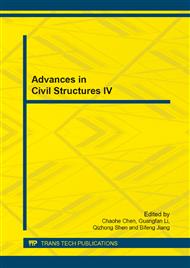p.818
p.822
p.830
p.835
p.839
p.846
p.850
p.854
p.858
ANSYS-Based Study in the New Composite Beam for Effective Flange Width
Abstract:
Effective flange width’s value of U-section steel-encased concrete composite beam was studied by ANSYS. Based on the static equivalent principle, the general rules of effective flange width changed with load are summarized by finite element analysis and considering the effect of 4 factors: width-span ratio, loading form, concrete thickness, and material strength including concrete strength and steel strength. The analysis results show that wide-span ratio and load form has a greater impact on the effective flange width; concrete thickness and material strength’s effects can be negligible.
Info:
Periodical:
Pages:
839-845
Citation:
Online since:
July 2014
Authors:
Price:
Сopyright:
© 2014 Trans Tech Publications Ltd. All Rights Reserved
Share:
Citation:


